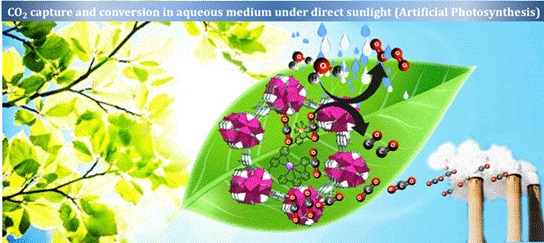Ministry of Science & Technology
Artificial photosynthesis to provide solutions for carbon capture and conversion
Posted On:
18 MAR 2021 9:58AM by PIB Delhi
Scientists have found a method to mimic nature’s own process of reducing carbon dioxide in the atmosphere, namely photosynthesis, to capture excess carbon dioxide in the atmosphere. This artificial photosynthesis (AP) harnesses solar energy and converts the captured carbon dioxide to carbon monoxide (CO), which can be used as a fuel for internal combustion engines.
In artificial photosynthesis (AP), scientists are essentially conducting the same fundamental process in natural photosynthesis but with simpler nanostructures. However, there are plenty of hurdles to overcome as a successful catalyst to carry out AP.
A team of Scientists from Jawaharlal Nehru Centre for Advanced Scientific Research, an autonomous institute of the Department of Science & Technology (DST), Government of India,designed and fabricated an integrated catalytic system based on a metal-organic framework (MOF-808) comprising of a photosensitizer (molecules which absorb light and transfer the electron from the incident light into another nearby molecule) that can harness solar power and a catalytic centre that can eventually reduce CO2. The work described above has been accepted for publication in the journal ‘Energy& Environmental Science’ of Royal Society of Chemistry, UK.
The scientists have immobilized a photosensitizer, which is a chemical called ruthenium bipyridyl complex ([Ru(bpy)2Cl2]) and a catalytic part which is another chemical called rhenium carbonyl complex ([Re(CO)5Cl]), inside the nanospace of metal-organic framework for artificial photosynthesis. Both these molecular entities stay in close proximity in the confined nano-space of a porous metal-organic framework system resulting in excellent CO2 uptake capability at room temperature. This synthetic strategy empowers efficient solar light-driven photocatalysis.
The developed catalyst exhibited excellent visible-light-driven CO2 reduction to CO with more than 99% selectivity. The catalyst also oxidizes water to produce oxygen (O2). The photocatalytic assembly, when assessed for CO2 reduction under direct sunlight in a water medium without any additives, showed superior performance of CO production. Being heterogeneous, the integrated catalytic assembly can be reused for several catalytic cycles without losing its activity.
JNCASR team believes this intricate design and synthetic approach will pave the way to develop new integrated catalytic systems for CO2 capture and conversion of different energy-rich C1 and C2 chemical feedstocks by mimicking artificial photosynthesis.


Authors of the work


Prof. Tapas. K. Maji SanchitaKarmakarDr.Soumitra Barman Faruk Ahamed Rahimi
[Publication link:DOI: 10.1039/D0EE03643A
For more details, Prof. Maji (tmaji@jncasr.ac.in; 9483540611) can be contacted.]
*****
SS/KGS
(Release ID: 1705690)